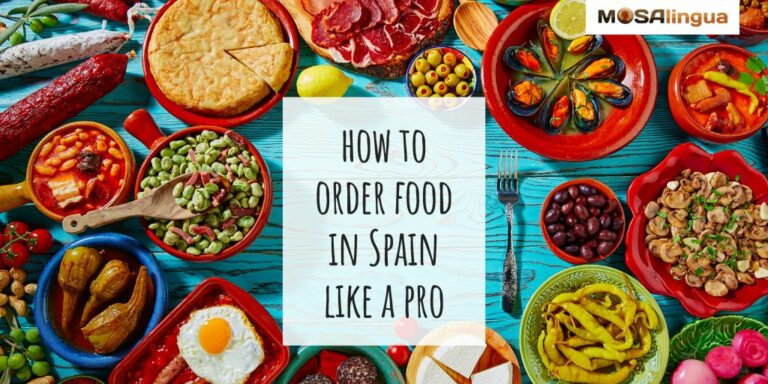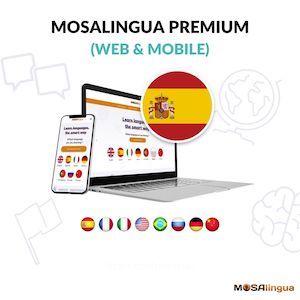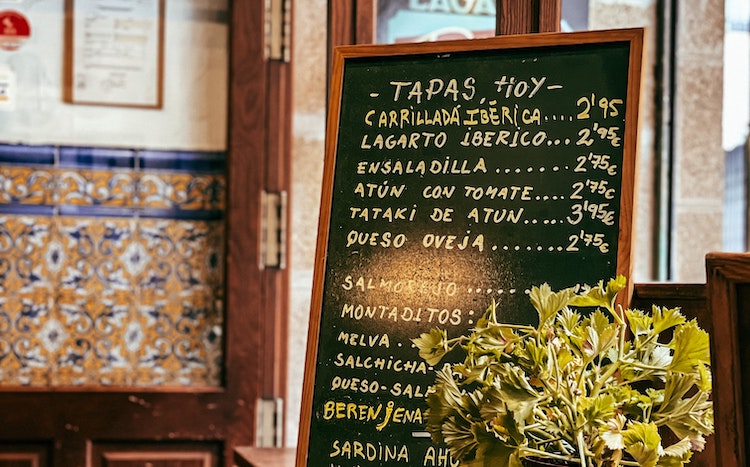Imagine this: you’re sitting on the terrace of a tapas bar in Madrid, soaking up the strong Spanish sun, chatting with your friends in between bites of salty tapas and cold cañas (small glasses of beer). The plates just keep coming—spicy patatas bravas, salty jamón ibérico, tortilla española packed with potatoes. But before you can dig into Spain’s delicious cuisine, you have to know how to order it! Read on to learn how to order food in Spain and sound like a pro with the right Spanish vocabulary.

How to Order Food in Spain Like a Pro
Food Culture in Spain
Spain has an incredible food culture. Not only is the food itself delicious, there are cultural rituals around food that encourage you to slow down, connect with the people around you, and savor the moment.
For example, lunch is typically the biggest meal of the day in Spain, and it’s common to spend at least an hour, often closer to two, enjoying your almuerzo. Historically, after the big meal, people would take a nap–or siesta–to allow all that food to digest and to get a break from the searing midday heat.
Nowadays, with many people in Spain working office jobs, the siesta is mostly a thing of the past. But the long and leisurely lunch is here to stay–no scarfing down a sad sandwich in 20 minutes over here!
Dinner can be a similarly languid affair. It starts late–around 9 pm–and often goes on for hours. Friends or family gather together to talk, laugh, and enjoy each other’s company while they eat and drink. In fact, as yummy as Spanish food is, the most important thing about mealtime in Spain is the chance to spend quality time with loved ones. It’s even common to see young children out at restaurants late into the night!
Another thing you should know is that–just like there are many different languages in Spain–there’s a lot of food diversity, too. You’ll find different tapas at a bar in Galicia than you will in Madrid. If you’re lucky, you’ll get to sample them all!
Learn how to order food in Spanish
The time has finally come! You’ve made your way to a bar in Spain and you’re ready to order some tapas.
🙅♂️ But first, here’s what not to say: “Puedo tener…?”
Look, nothing bad will happen if you do say this–you’ll just get a bemused look from your waiter, and they might categorize you as a guiri (foreigner).
Using this phrase is a common mistake because that’s exactly what we say in English (“Can I have an orange juice?”). But when you translate this phrase directly into Spanish, it doesn’t actually make any sense.
Here’s a tip: when you’re making a request in Spanish (like when you order food in Spain!), you should focus on what action you want the other person to do for you. So instead of saying “Puedo tener un zumo de naranja?” (“Can I have an orange juice?”), say “Me puede traer un zumo de naranja, por favor?” (“You bring me an orange juice, please?”)
At first, talking this way might seem blunt or even rude to you, especially if you were raised in a culture that uses extra polite language. I was raised in the American South, where we say “please” and “thank you” almost as often as we breathe.
But Spanish is a direct language, and Spain is a culturally direct country. Getting right to the point (while still being respectful, of course) is what’s expected.
You might cringe a little inside the first few times you tell a camarero (waiter) to “Tráigame un vaso de vino tinto, por favor” (“Bring me a glass of red wine, please”). But with some practice, speaking with directness will come naturally!
How to order food in Spain in the most polite way
Another quick note: you may be wondering how to order food in Spanish without offending the wait staff. Should you address restaurant staff formally (by conjugating in the second person) or informally (conjugating in the third person)?
This is a tricky cultural nuance that will vary based on how upscale the restaurant is, how close in age you are to your waiter, and other things. Most of the time in Spain, it’s acceptable to use the informal and no one will be offended. But if you want to be on the safe side of things, just stick to the formal third person.
Need-to-Know Phrases for Ordering at a Restaurant or Bar in Spain
“Hola, buenas”
First things first: say hello! This is a slightly informal but very widely used greeting in Spain. Make sure you greet the waiter who meets you at the door and/or your table.
“¿Puedo sentarme en la terraza?”
Terrace culture is HUGE in Spain. Spaniards love to meet up and spend hours talking and relaxing over beverages and tapas, and thanks to Spain’s mild, dry climate, you’ll find the terraces outside bars and restaurants packed with people year round. When you want to join them, be sure to ask the waiter if it’s okay.
“¿Me pone una caña?”
Remember when I said that they use language much more directly in Spain than in the United States? Well, I wasn’t joking! In English, this directly translates to “You put me a (small) beer?” While this would earn you a strong side-eye if you said it in the United States, it’s totally expected and normal in Spain.
“¿Me trae la carta, por favor?”
If you’re seated and there’s no menu, just ask your waiter for one, no big deal. Restaurant service in Spain is not the same as in the US. The waiter will not check up on you every five minutes, and sometimes, if it’s busy, they might not even notice that you’ve taken a seat unless you catch their attention! Personally, I prefer this hands-off approach. Don’t be shy about locking eyes with a waiter and raising your arm to signal “hey, I’m here!”
Pro tip: when you want to say “menu,” don’t use the false friend “menú.” In Spain, the “menú del día” refers specifically to a set menu with multiple courses served during lunchtime hours. It’s a staple in Spanish culture, and usually includes a glass of wine. (Yes–wine at lunch! Go ahead and book that ticket to Barcelona now, I’ll wait…)
“Todavía no estoy listo” / “Necesito unos minutos más, por favor”
Sometimes you’re not quite ready to order by the time your waiter comes by. It’s hard to choose between all those tasty tapas! This is what to say if you need some more time to ponder the menu. Just be careful–if you send your waiter away, they might not come back unless you catch their attention again.
“¿Qué me recomienda?”
It’s always a good idea to ask for recommendations if you can’t decide what to order, or if you’re curious about the local cuisine and don’t know quite where to start. (Although it’s never a bad idea to order raciones, or larger sharable portions, of everything!)
“¿Lleva…este plato?”
Maybe you have a food allergy or intolerance (or you just really hate anchovies or something–no judgment!). If that’s the case, here’s how to ask if a dish has a certain ingredient, so you can order food in Spain without fear of getting something you can’t eat or don’t like.
“Quisiera/Me trae/Para mí…, por favor”
When you’re ready to go ahead and order your food, use one of these common phrases. “Quisiera” has a more formal tone, while “Me trae…” sounds a little more informal and relaxed.
If you don’t even want to worry about conjugation, you can just say, “para mi, [food]” or simply “[food], por favor.” In fact, if you want to impress your new Spanish friends, those last two options might even sound the most native!
“¡Qué rico!/¡Qué bueno!”
You probably won’t be able to tear yourself away from a bowl of fresh gazpacho or a plate of crispy, melty croquetas long enough to form words, but if you want to express how delicious your food is, here’s what you should say.
Start improving your Spanish today

Good news: we can help!
More good news: you can get started for free! With your free trial, you can test drive the most effective method for learning Spanish for the next 15 days!
Vocabulary flashcards, videos with subtitles, audiobooks, articles adapted to your level – with MosaLingua Premium (Web & Mobile), you’ll have access to all this and more. Get started right now. It’s free—and risk-free—to try!
“La cuenta, por favor”
Okay, so you’ve stuffed yourself with all the tapas you can manage and you’re ready to pay your bill and head home for a nice long siesta… but your waiter is nowhere to be seen.
Remember that food service is pretty hands-off in Spain. Once your food is on the table, your waiter will probably leave you alone until you signal for their attention. If you don’t proactively ask for your check, you could be sitting there for hours, wondering if your waiter has forgotten about you.
Like I explained earlier, it’s an essential part of Spanish culture to spend hours chatting over food and drinks. It would be considered extremely rude for a waiter to just assume you are finished and bring you a check.
So the moment has finally come–this is your chance to practice the subtle art of signaling for la cuenta. You must master this skill if you want to fit in while eating at a restaurant in Spain.
All you have to do is catch eyes with your waiter and maybe raise your hand a bit. When they make their way to your table, say, “¿La cuenta, por favor?” (Although sometimes, all you need to do is pretend to sign a check in the air and the waiter will come over with your bill. Ah, the magic of nonverbal communication!)
Conclusion
Food is a vital and vibrant part of Spanish culture. If you get the chance, you should experience it as the Spanish do–enjoying a leisurely lunch, hopping from tapas bar to tapas bar for summery pan con tomate, or gathering with friends on a restaurant terrace, sipping on tinto de verano as the night wakes up around you. Ordering food in Spanish doesn’t have to be hard! If you use these tips, you’ll be enjoying unos pintxos like a local in no time.






Comments